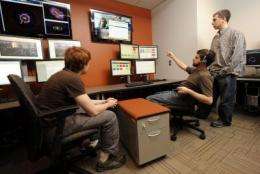Vanderbilt sets up 1 of 8 virtual control rooms for LHC in US

On Tuesday, Mar. 30, the world's most powerful particle accelerator is scheduled to begin slamming subatomic particles together at record energies and recording the consequences of the micro-explosions that result, opening a new chapter in scientists' efforts to answer some of the most fundamental questions in physics.
Seven Vanderbilt physicists are playing an important role in this international experiment, one that could significantly alter our basic understanding of the world we live in. The giant machine, called the Large Hadron Collider (LHC), was constructed by the European Organization for Nuclear Research (CERN) and is located in Switzerland. Research Assistant Professor William Gabella is working full time at CERN and is attending the event in person. The other six Vanderbilt researchers - Professors Victoria Greene, Charles Maguire and Paul Sheldon, Associate Professors Will Johns and Julia Velkovska, and Professor Emeritus Medford Webster - are participating virtually, either through facilities at the Fermi National Laboratory or through a state-of-the-art control center that the group has set up in the physics building on campus with the support of the College of Arts & Science.
The new center will allow the physicists and their students to participate more fully in the experiment. "In the past, you couldn't fully participate in an experiment unless you were on site. Remote sites like ours represent the globalization of big science experiments," Sheldon said. The participants agree that the center will not only allow them to be more fully involved but it will give students greater opportunities as well. In previous experiments, the graduate students' involvement was limited by the funding available to pay for them to stay on site. The center will also allow undergraduates to participate. "We've gotten a lot of requests from undergraduates who are really excited about the opportunity," Greene reported.
The Vanderbilt virtual control room is one of eight that have been set up in the United States at locations like the Fermi National Accelerator Laboratory in Illinois, California Institute of Technology and the University of Florida, Gainesville. The room is filled with flat-panel displays filled with data streamed directly from Switzerland about the operation of one of the LHC's four detectors, called the Compact Muon Solenoid (CMS), on which the Vanderbilt scientists are working.
"As the data from the instrument is logged and small percentage is pulled out and used to monitor the quality of the data in real time," explained Velkovska. "That is the data we can monitor from here." Vanderbilt team members will be standing official watches during the day, which corresponds to the middle of the night in Switzerland. If one of the watch-standers spots a problem, she can report it via a 24/7 videoconferencing system that connects the Vanderbilt station to the operators in the main CMS control room in Switzerland.
Vanderbilt is also playing a critical role in processing the mountains of raw data produced by the CMS detector. After it is logged in Switzerland, it is transmitted to Fermilab where it is recorded on magnetic tape. Then it is transmitted to Vanderbilt's supercomputer center, the Advanced Computing Center for Research and Education, where it will be processed into a form that scientists can analyze and distributed to all the CMS team members. According to Maguire, ACCRE's capacity will almost double in the next few years in order to handle all the data.
The LHC, with its $9 billion budget, is the biggest game in the world for high-energy physicists. It consists of a 17-mile long circular racetrack buried underground. Super-strength magnets accelerate and direct two beams of subatomic particles around the track at speeds up to 99.999999 percent of the speed of light. One beam travels in the clockwise direction and the other travels counterclockwise. At four points around the track the magnets switch the beams into the same path to produce head-on collisions. Each of the interaction zones is surrounded by massive detectors that record the paths of the thousands of sub-atomic particles created in these collisions. Analyzing these records allows the scientists to reconstruct what takes place in these sub-atomic explosions. The Vanderbilt physicists are members of the 3,600-member team operating the CMS detector
Among the scientific questions that the CMS experiment will be probing are: What is the origin of mass? What was the nature and properties of the quark gluon plasma, the primordial soup that filled the universe immediately after the Big Bang? Why is the universe filled with matter instead of a mixture of matter and its electrical opposite, antimatter? What is the mysterious dark matter that affects the shapes of galaxies but which scientists have not been able to detect directly? Does the universe contain dimensions beyond width, height, depth and time?
Provided by Vanderbilt University



















